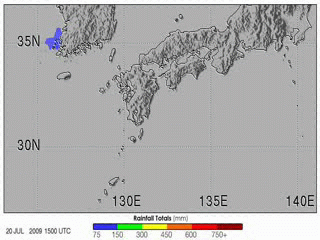Файл:Heavy Rains in Southern Japan.gif
Перейти до навігації
Перейти до пошуку
Heavy_Rains_in_Southern_Japan.gif (320 × 240 пікселів, розмір файлу: 8,35 МБ, MIME-тип: image/gif, кільцеве, 268 кадрів, 8,0с)
Історія файлу
Клацніть на дату/час, щоб переглянути, як тоді виглядав файл.
| Дата/час | Мініатюра | Розмір об'єкта | Користувач | Коментар | |
|---|---|---|---|---|---|
| поточний | 21:56, 31 липня 2009 |  | 320 × 240 (8,35 МБ) | Originalwana | {{Information |Description={{en|1=The 2009 summer monsoon brought torrential rains to south western Japan in July. This animatin shows rainfall estimates for southern Japan and the surrounding region from July 20–27. The most prominent feature is a larg |
Використання файлу
Така сторінка використовує цей файл:
Глобальне використання файлу
Цей файл використовують такі інші вікі:
- Використання в cs.wikipedia.org
- Використання в en.wikipedia.org
- Використання в fi.wikipedia.org
- Використання в id.wikipedia.org
- Використання в ja.wikipedia.org
- Використання в ms.wikipedia.org
- Використання в si.wikipedia.org
- Використання в te.wikipedia.org
- Використання в vi.wikipedia.org
- Використання в www.wikidata.org
- Використання в zh.wikipedia.org


